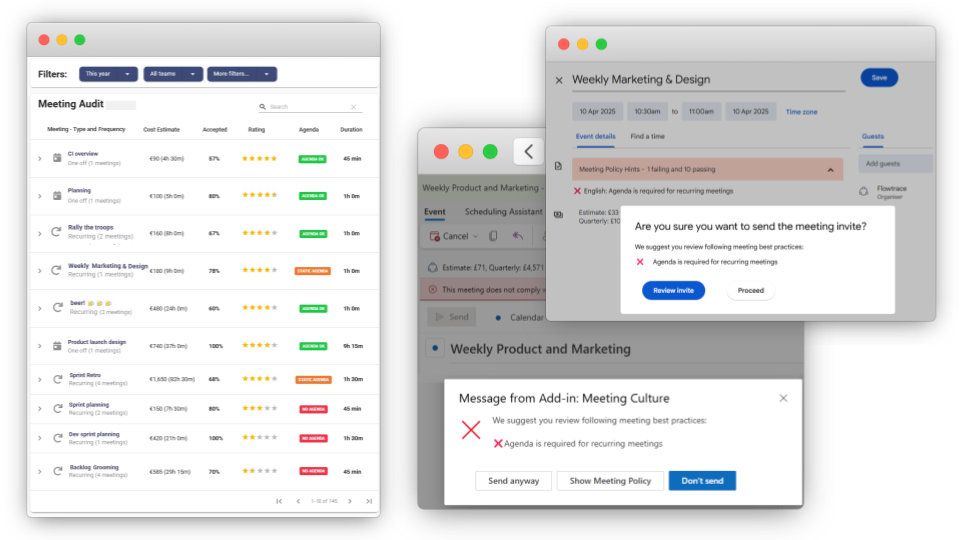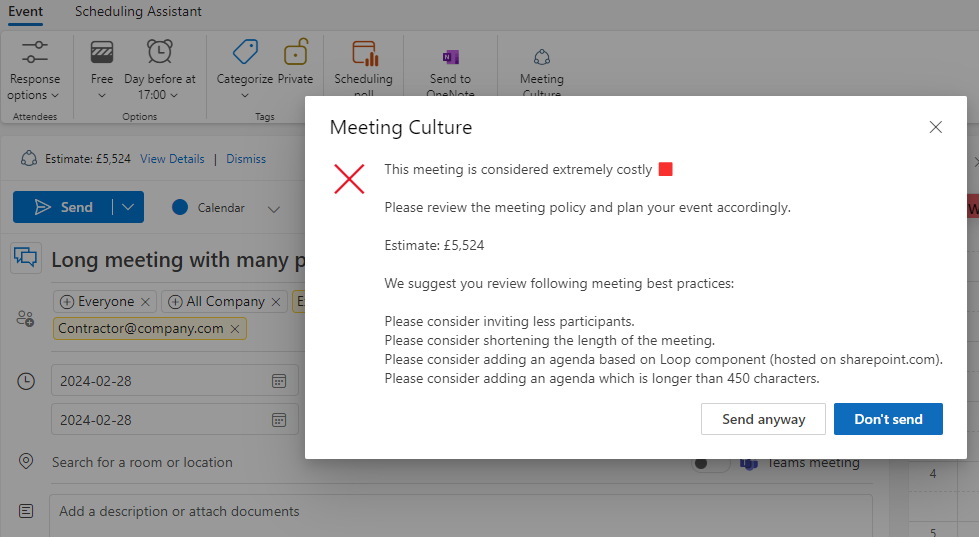Productivity by Meetings: The Secret to Time, Cost, and Collaboration
Transform your meetings into productivity engines. Discover actionable strategies to optimize time, improve decision-making, and enhance...
Learn how to change company meeting culture with structured guidelines, behavioral nudges, and data-driven strategies to boost productivity, engagement, and decision-making.
Changing meeting culture isn’t simply a matter of issuing new guidelines, it requires overcoming deeply ingrained habits and social norms. Behavioral change in any organization is hard work because people naturally resist altering routines that feel familiar and safe, even when those routines are clearly inefficient. Left unchecked, outdated meeting practices perpetuate a cycle where every problem defaults to “let’s schedule a meeting,” reinforcing a status quo that few challenge.
Over time, these entrenched habits take a heavy toll on both productivity and morale. Repetitive, unfocused gatherings stretch into afternoons, leaving little time for meaningful work. Participants emerge from back-to-back calls drained and disengaged, questioning whether their contributions truly matter. To avoid this downward spiral, companies must take an intentional, systematic approach, one that acknowledges the human difficulty of change and builds structured support for better meeting behaviors.
Before you can change meeting behaviors, you need a clear snapshot of today’s reality. Start with a meeting culture audit that logs total meeting hours, distribution of meeting types, and observable behaviors, such as how often agendas are attached and meetings start on time.

Next, use meeting analytics to uncover hidden patterns. Track agenda presence rates to see how many sessions begin without a clear purpose. Measure punctuality metrics to identify teams that routinely start late or overrun. Analyze invite-count trends to pinpoint where bloated attendee lists are inflating costs and diluting focus.
According to Microsoft’s 2025 Work Trend Index, 68% of employees report they don’t have enough uninterrupted focus time during the workday, largely due to an overload of meetings. By combining a structured audit with these real-time analytics, such as Meeting Analytics Every Company Should Track, you’ll establish the baseline evidence needed to drive targeted cultural change.
To begin transforming your meeting culture, clearly articulate the outcomes every session must deliver, efficiency, alignment, equity, and decision quality. When meeting purposes are murky, people treat them as catch-alls, leading to unfocused discussions and wasted time. According to a 2025 Gartner 2025 Future of Work Trends,” February 2025, 60% of organizations lack a standardized meeting framework, contributing directly to meeting overload and unclear expectations. By framing each meeting around these four pillars, you create a shared language for what “good” looks like.
Once your objectives are defined, develop a meeting taxonomy that classifies all gatherings into categories, decision forums, brainstorming sessions, project kick-offs, and status updates, each with tailored behavioral standards. For example, decision forums require a pre-meeting data packet and a clear RACI matrix; brainstorming sessions mandate open-ended agenda items and a designated scribe. Embedding these protocols into meeting templates ensures consistency, while agenda validation rules enforce compliance before any invite is sent.
Finally, align your taxonomy with your organizational values and operational rhythms. If you promote an async-first culture, designate certain updates as asynchronous, using shared docs or brief video summaries instead of live meetings. If equity is a priority, set standards for participation balance and diversity of invitees, tracking these through meeting equity analytics. By codifying both what types of meetings occur and how they should run, you give teams the guardrails they need to adopt new habits, and you make cultural change stick.
Behavioral inertia, fear of missing out, and reliance on social proof are powerful barriers to meeting culture transformation. When people default to “the way we’ve always done it,” it’s often because they worry that skipping a meeting could leave them uninformed or out of the loop. Overcoming this requires clear communication of new norms, such as trimmed agendas, shorter defaults, and protected focus blocks, and visible examples of success. Leveraging meeting rules for calendar optimization and calendar agenda validation reinforces these norms at the moment of scheduling, nudging organizers and attendees toward better habits.
Leadership endorsement is critical: when executives model concise, agenda-driven sessions and honor no-meeting days, it signals that change is real and valued. Pair this with peer accountability, encouraging teams to review each other’s meeting practices via meeting feedback analytics, and you create a supportive environment for change. Tracking progress through meeting analytics dashboards and showcasing wins in cross-functional reviews turns abstract goals into measurable achievements, making sustainable meeting culture change possible.
Behavioral nudges leverage subtle prompts and defaults to guide people toward better choices without heavy-handed enforcement. In a meeting context, nudges can shift organizer and attendee behavior at the moment of scheduling, when habits are formed.

For instance, setting shorter default durations (25 or 50 minutes) encourages concise sessions, while no-meeting days automatically block focus time. Embedding agenda-required fields in invite forms ensures every session starts with clear objectives, and tracking attendance consistency reminds organizers to keep invites lean.
Concrete examples of effective nudges include:
By integrating these nudges directly into calendar workflows, organizations can transform meeting design from an afterthought into an intentional, data-backed practice, driving sustained improvements in collaboration and efficiency.
Flowtrace’s invite-validation feature embeds behavioral nudges directly into the scheduling workflow, turning every meeting invite into an opportunity for alignment. When an organizer creates a new event, the system checks for essential elements, such as a clear agenda and justified participant list, using calendar agenda validation.

If an invite is missing these components, the organizer receives a prompt to refine their session objectives before the meeting can be sent. This gentle interruption creates a moment of reflection, encouraging better practices at the source.
To set up invite validation, administrators configure three core prompts:
By weaving these validation steps into everyday scheduling, organizations shift their meeting culture from reactive to intentional, creating consistent meeting habits that scale across teams.
Creating standardized meeting templates with predefined roles and expected outcomes ensures consistency across your organization. For each meeting type, be it a decision session or a brainstorming workshop, provide a template outlining the facilitator, timekeeper, and scribe roles, required agenda items, and clear deliverables. Embedding these structures into your calendar tool using meeting templates and a defined meeting taxonomy helps organizers hit the ground running and guarantees that every session starts with the right framework.

To reinforce these best practices, deploy automated reminders and calendar rules that check compliance at scheduling time. For example, configure prompts that remind organizers to apply the correct template, enforce agenda validation, and flag sessions that breach your meeting invite rules. By automating these governance mechanisms, you shift policy enforcement from manual oversight to seamless, real-time guidance, making high-quality meetings the default, not the exception.
To track the effectiveness of your meeting culture transformation, focus on key metrics that reflect both adherence to new standards and tangible productivity gains. Monitor your agenda compliance rate to ensure organizers consistently define clear objectives, and track meeting load reduction to confirm that calendars are becoming less congested. Measure decision velocity, the time between problem identification and resolution, to quantify how faster, more focused meetings accelerate outcomes. These metrics can be visualized through meeting analytics dashboards and agenda validation reports.
.png?width=960&height=540&name=Marketing%20Images%20(11).png)
Reinforcing change requires continuous feedback loops and regular culture health reviews. Conduct quarterly pulse surveys to gather qualitative input on meeting effectiveness and team sentiment, and integrate these insights into your analytics platform. Share aggregated results in leadership reviews and team retrospectives, using meeting feedback analytics to pinpoint areas for improvement. By consistently measuring progress and actively communicating wins and challenges, you cement new behaviors into the organizational fabric and ensure that your meeting culture continues to evolve.
Behavioral change is an ongoing process. After your initial policies and nudges are in place, review the data and feedback to refine your approach. Use meeting analytics and agenda validation rates to identify which rules and templates are most effective, and which need adjustment. Incorporate insights from pulse surveys to understand user sentiment, then tweak justification prompts or attendee limits accordingly.
Once you’ve proven success in one team or department, scale these proven practices across the organization. Leverage role- and team-based dashboards to tailor policies to different functions, ensuring that what works for engineering huddles can be adapted for client calls or executive briefings. By iterating with data and methodically rolling out best practices, you create a multiplier effect where small wins compound into a cohesive, high-performing meeting ecosystem.
Transforming meeting culture requires more than a single initiative, it’s a continuous journey of audit, definition, nudges, measurement, and iteration. Each step builds the foundation for the next, moving from haphazard gatherings to structured, outcome-driven sessions.
The long-term payoff is substantial: a meeting culture that not only respects everyone’s time but actively drives performance, enhances engagement, and accelerates decision-making. When collaboration becomes intentional, meetings evolve from routine obligations into strategic accelerators that power your organization’s success.
Changing meeting culture means altering long-standing habits and social norms. People fear missing out on important information and default to scheduling meetings “just in case.” Overcoming this inertia requires clear expectations, visible leadership modeling, and structured support—such as automated Flowtrace nudges and calendar rules—to guide teams from reactive to intentional collaboration.
Start with a meeting culture audit: measure total meeting hours, agenda usage rates, on-time starts, and invite-count patterns. Combine Flowtrace’s analytics dashboards with spot-check manual audits or pulse surveys to map where meetings are working—and where they’re wasting time.
A meeting taxonomy classifies gatherings into types (e.g., decision forums, brainstorming workshops, status updates), each with its own agenda template, participant roles, and time limits. This framework—supported by Flowtrace’s template enforcement—ensures every session has a clear purpose and consistent structure, driving alignment and efficiency.
Behavioral nudges—like default shorter durations, mandatory agenda fields, and attendee limits—prompt organizers toward better choices at scheduling time. Tools like Flowtrace’s invite validation embed these prompts directly into the calendar workflow, making good meeting practices automatic rather than optional.
Focus on a balanced set of indicators: agenda compliance rate, percentage of meetings starting on time, meeting load per person, and decision velocity. Supplement these with regular pulse surveys or post-meeting polls. Platforms like Flowtrace unify these metrics in one dashboard, letting you iterate on policies and scale what works.
Transform your meetings into productivity engines. Discover actionable strategies to optimize time, improve decision-making, and enhance...
Identify what tools analyze company meetings with a blend of automated analytics, manual audits, and participant feedback to boost productivity and...
Run better company meetings by redesigning systems, tracking data, and treating meeting time as a strategic investment to boost productivity and...